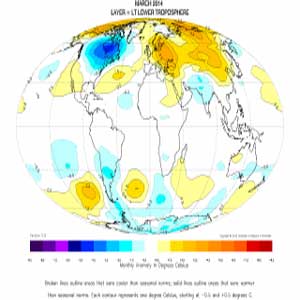North America was cooler than normal, while Eurasia was warmer. March was the sixth month in a row with below normal temperatures in the lower 48 states.
Compared to seasonal norms, the coldest place in Earth's atmosphere in March was over south central Hudson Bay, where temperatures were as much as 4.87 C (about 8.8 degrees Fahrenheit) cooler than seasonal norms. Compared to seasonal norms, the warmest departure from average in March was along Russia's northernmost Arctic coast near Faddey Bay. Temperatures there were as much as 4.7 C (8.5 degrees Fahrenheit) warmer than seasonal norms.
As part of an ongoing joint project between UAHuntsville, NOAA and NASA, Christy and Dr. Roy Spencer, an ESSC principal scientist, use data gathered by advanced microwave sounding units on NOAA and NASA satellites to get accurate temperature readings for almost all regions of the Earth. This includes remote desert, ocean and rain forest areas where reliable climate data are not otherwise available.
The satellite-based instruments measure the temperature of the atmosphere from the surface up to an altitude of about eight kilometers above sea level. Once the monthly temperature data is collected and processed, it is placed in a "public" computer file for immediate access by atmospheric scientists in the US and abroad.
Neither Christy nor Spencer receives any research support or funding from oil, coal or industrial companies or organizations, or from any private or special interest groups. All of their climate research funding comes from federal and state grants or contracts.
March temperatures (preliminary)
Global composite temp.: +0.17 C (about 0.31 degrees Fahrenheit) above 30-year average for March.
Northern Hemisphere: +0.34 C (about 0.61 degrees Fahrenheit) above 30-year average for March.
Southern Hemisphere: ±0.00 C (about 0.00 degrees Fahrenheit) at 30-year average for March.
Tropics: ±0.00 C (about 0.00 degrees Fahrenheit) at 30-year average for March.
February temperatures (revised):
Global Composite: +0.17 C above 30-year average
Northern Hemisphere: +0.32 C above 30-year average
Southern Hemisphere: +0.02 C above 30-year average
Tropics: -0.10 C below 30-year average
(All temperature anomalies are based on a 30-year average (1981-2010) for the month reported.)

















Related Items
A tiny computer's big role in unveiling Universe's earliest whispers
Immigrants in Europe and North America earn less than natives
A battle for dignity, Desperate civilians cry for safe public toilets